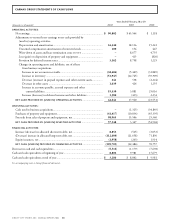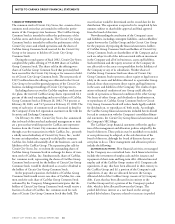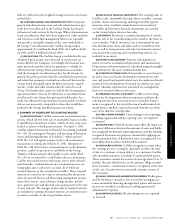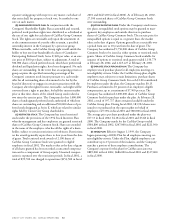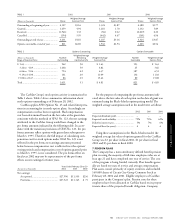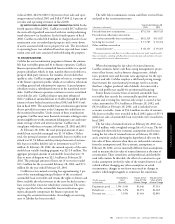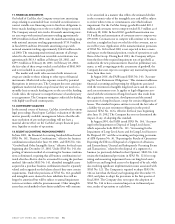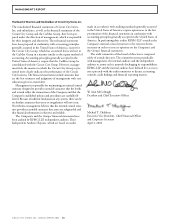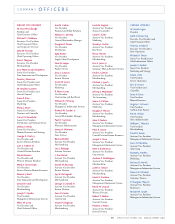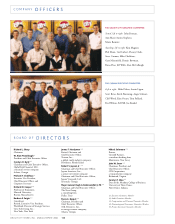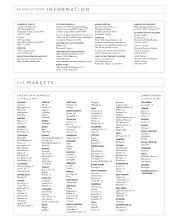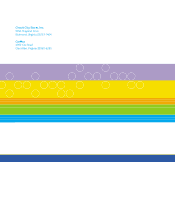CarMax 2002 Annual Report Download - page 98
Download and view the complete annual report
Please find page 98 of the 2002 CarMax annual report below. You can navigate through the pages in the report by either clicking on the pages listed below, or by using the keyword search tool below to find specific information within the annual report.
11. FINANCIAL DERIVATIVES
On behalf of CarMax, the Company enters into amortizing
swaps relating to automobile loan receivable securitizations to
convert variable-rate financing costs to fixed-rate obligations to
better match funding costs to the receivables being securitized.
The Company entered into twelve 40-month amortizing inter-
est rate swaps with notional amounts totaling approximately
$854.0 million in fiscal 2002, nine 40-month amortizing swaps
with notional amounts totaling approximately $735.0 million
in fiscal 2001 and four 40-month amortizing swaps with
notional amounts totaling approximately $344.0 million in fis-
cal 2000. The remaining total notional amount of all swaps
related to the automobile loan receivable securitizations was
approximately $413.3 million at February 28, 2002, and
$299.3 million at February 28, 2001. At February 28, 2002,
the fair value of these swaps totaled a net liability of $841,000
and were included in accounts payable.
The market and credit risks associated with interest rate
swaps are similar to those relating to other types of financial
instruments. Market risk is the exposure created by potential
fluctuations in interest rates. The Company does not anticipate
significant market risk from swaps because they are used on a
monthly basis to match funding costs to the use of the funding.
Credit risk is the exposure to nonperformance of another party
to an agreement. The Company mitigates credit risk by dealing
with highly rated bank counterparties.
12. CONTINGENT LIABILITIES
In the normal course of business, CarMax is involved in various
legal proceedings. Based upon CarMax’s evaluation of the infor-
mation presently available, management believes that the ulti-
mate resolution of any such proceedings will not have a
material adverse effect on the CarMax Group’s financial posi-
tion, liquidity or results of operations.
13. RECENT ACCOUNTING PRONOUNCEMENTS
In June 2001, the Financial Accounting Standards Board issued
SFAS No. 141, “Business Combinations,” effective for business
combinations initiated after June 30, 2001, and SFAS No. 142,
“Goodwill and Other Intangible Assets,” effective for fiscal years
beginning after December 15, 2001. Under SFAS No. 141, the
pooling of interests method of accounting for business combina-
tions is eliminated, requiring that all business combinations ini-
tiated after the effective date be accounted for using the purchase
method. Also under SFAS No. 141, identified intangible assets
acquired in a purchase business combination must be separately
valued and recognized on the balance sheet if they meet certain
requirements. Under the provisions of SFAS No. 142, goodwill
and intangible assets deemed to have indefinite lives will no
longer be amortized but will be subject to annual impairment
tests in accordance with the pronouncement. Other intangible
assets that are identified to have finite useful lives will continue
to be amortized in a manner that reflects the estimated decline
in the economic value of the intangible asset and will be subject
to review when events or circumstances arise which indicate
impairment. For the CarMax Group, goodwill totaled $20.1
million and covenants not to compete totaled $1.5 million as of
February 28, 2002. In fiscal 2002, goodwill amortization was
$1.8 million and amortization of covenants not to compete was
$931,000. Covenants not to compete will continue to be amor-
tized on a straight-line basis over the life of the covenant, not to
exceed five years. Application of the nonamortization provisions
of SFAS No. 142 in fiscal 2003 is not expected to have a mate-
rial impact on the financial position, results of operations or cash
flows of the Group. During fiscal 2003, the Company will per-
form the first of the required impairment tests of goodwill, as
outlined in the new pronouncement. Based on preliminary esti-
mates, as well as ongoing periodic assessments of goodwill, the
Company does not expect to recognize any material impairment
losses from these tests.
In August 2001, the FASB issued SFAS No. 143, “Account-
ing For Asset Retirement Obligations.” This statement addresses
financial accounting and reporting for obligations associated
with the retirement of tangible long-lived assets and the associ-
ated asset retirement costs. It applies to legal obligations asso-
ciated with the retirement of long-lived assets that result from
the acquisition, construction, development and the normal
operation of a long-lived asset, except for certain obligations of
lessees. This standard requires entities to record the fair value of
a liability for an asset retirement obligation in the period
incurred. SFAS No. 143 is effective for fiscal years beginning
after June 15, 2002. The Company has not yet determined the
impact, if any, of adopting this standard.
In August 2001, the FASB issued SFAS No. 144, “Account-
ing for the Impairment or Disposal of Long-Lived Assets,”
which supersedes both SFAS No. 121, “Accounting for the
Impairment of Long-Lived Assets and for Long-Lived Assets to
Be Disposed Of,” and the accounting and reporting provisions
of APB Opinion No. 30, “Reporting the Results of Operations-
Reporting the Effects of Disposal of a Segment of a Business,
and Extraordinary, Unusual and Infrequently Occurring Events
and Transactions,” related to the disposal of a segment of a
business (as previously defined in that Opinion). SFAS No. 144
retains the fundamental provisions in SFAS No. 121 for recog-
nizing and measuring impairment losses on long-lived assets
held for use and long-lived assets to be disposed of by sale, while
also resolving significant implementation issues associated with
SFAS No. 121. The Company is required to adopt SFAS No.
144 no later than the fiscal year beginning after December 15,
2001, and plans to adopt the provisions in the first quarter of
fiscal 2003. The Company does not expect the adoption of
SFAS No. 144 to have a material impact on its financial posi-
tion, results of operations or cash flows.
CIRCUIT CITY STORES, INC. ANNUAL REPORT 2002 96


